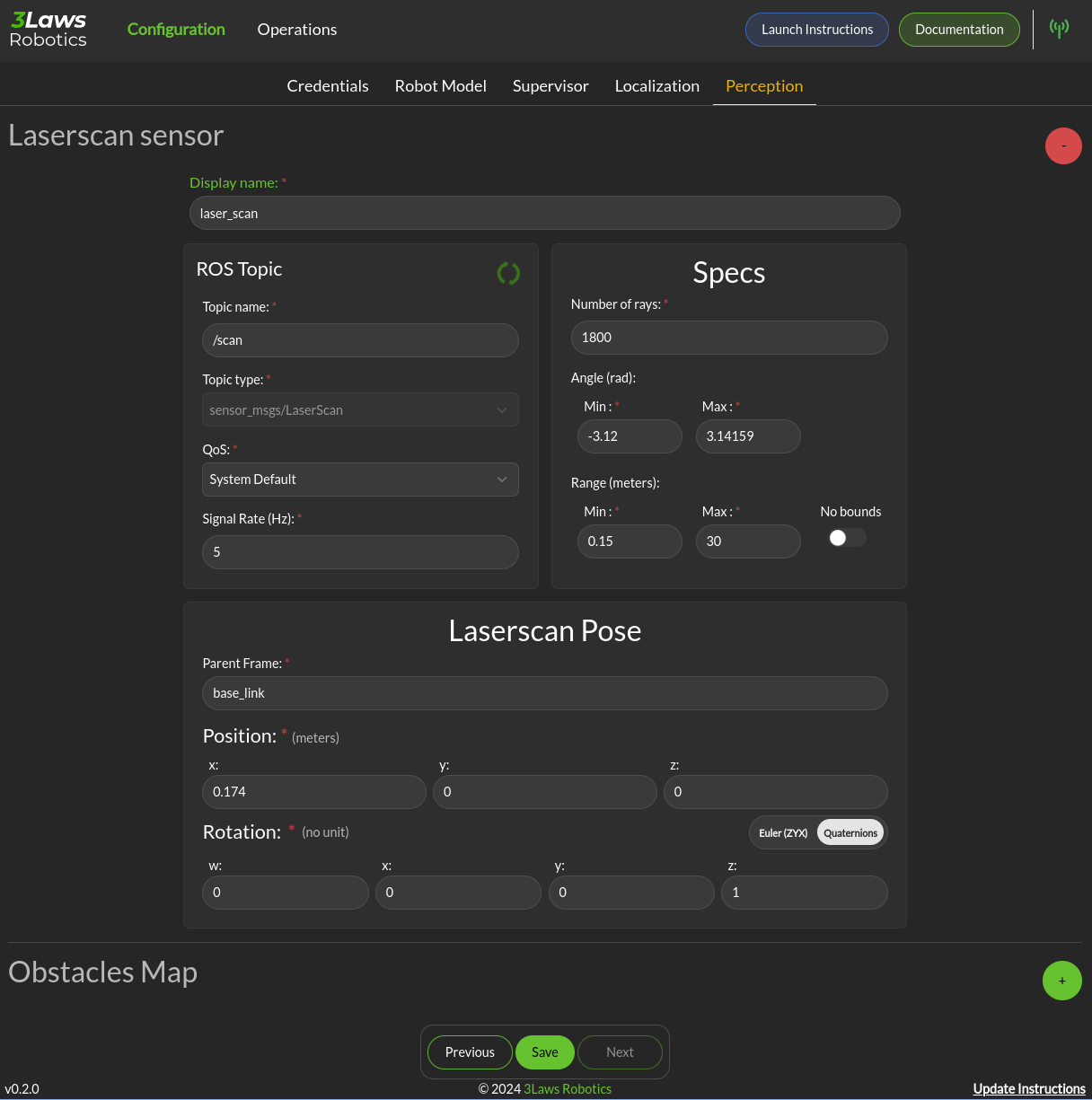Perception
Collision avoidance uses settings in this dialog to describe the sensors used during operation.

Laserscan sensor: The Supervisor processes data points from a single 2-dimensional laser scanner (LIDAR).
Display name: This display name is used when aggregated statistics about the scanner are uploaded to the 3Laws cloud dashboard. This name is chosen by the user to help keep track of the scanner, e.g. “front_lidar”.
ROS Topic: Supervisor needs to subscribe to the ROS message published by the LIDAR, so this topic name (plus type, quality-of-service, and expected signal rate) need to match the sensor’s output. ros2 topic with options list, info, hz can be useful to obtain this information.
Specs: The expected number of points per scan along with the first (typically minimum) and last (typically maximum) angle must be specified so that the angular resolution can be calculated for the nominal case. The first and last angle values should normally describe a laser that scans in the clockwise direction, so the first is smaller than the last. However, if the laser scans in the counter-clockwise direction the first angle should be set to be smaller than the last. It is very important that the total range of the laser is less than 2π. The Supervisor does not disambiguate angles if the total field is larger than 2π. The scanner’s range can be set so that readings smaller than the minimum or larger than the maximum are discarded.
Laserscan Pose: The orientation and position of the laserscan relative to the vehicle body or whichever frame is used must be specified. As with the robot’s body position, the user is advised to plot the data in rviz to ensure that the geometry is set correctly.
Obstacle Map: An existing perception system can be used instead of a 2D-LIDAR, but it most provide an ObjectArray that matches the definition for an lll_msgs/ObjectArray. The definition is as follows:
std_msgs/Header header
Object[] objects
where Object[] is defined by:
std_msgs/Header header
# Identifier of the object
string id
# Object geometry, and pose of geometry in object frame
ObjectGeometry geometry
# Object pose world frame
geometry_msgs/PoseWithCovariance pose
# Object velocity in object frame
geometry_msgs/TwistWithCovariance velocity
# Object behavior model
# Bounds on object frame velocity (considered inactive if non finite)
geometry_msgs/Twist velocity_upper_bounds
geometry_msgs/Twist velocity_lower_bounds
# Bounds on object frame velocity norms (considered inactive if strictly less than 0)
float64 linear_velocity_norm2_bound
float64 angular_velocity_norm2_bound
# Bounds on object frame acceleration (considered inactive if non finite)
geometry_mix's/Accel acceleration_upper_bounds
geometry_msgs/Accel acceleration_lower_bounds
# Bounds on object frame acceleration norms (considered inactive if strictly less than 0)
float64 linear_acceleration_norm2_bound
float64 angular_acceleration_norm2_bound
Important
When using obstacle lists, if the obstacles are in the world coordinate frames, the Supervisor (Run-time Assurance) use of localization must be enabled in the Supervisor tab.